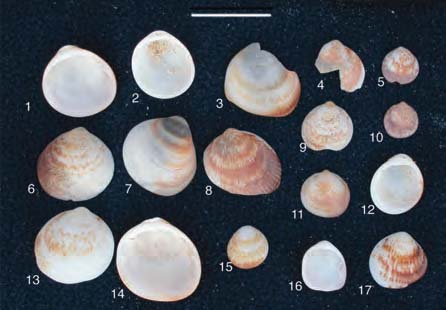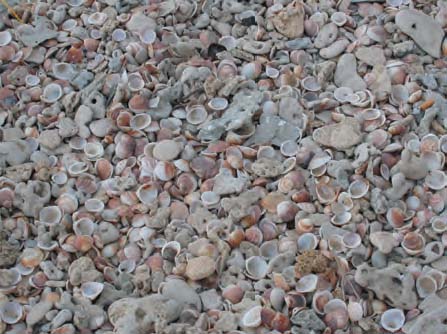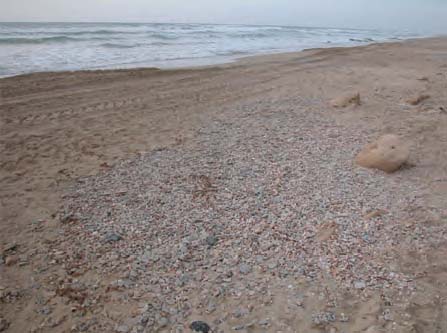|
Dog cockle (Glycymeris) shells, often in large numbers, are a common sight on the sandy Mediterranean beaches of southern Israel. Most are worn but still fairly brightly coloured (Fig. 6, page 9). Israeli conchologists have for some time wondered about their age because the dominant species in these accumulations, G. insubrica (Brocchi 1814, = G. violascens Lamarck 1819), is now very uncommon or even absent today – only a few specimens have been taken live off the Israeli coast in the last hundred years. In a recent paper, Sivan et al. (2006) summarise the literature and publish new information including six new radiocarbon dates. There are now 14 dates on Glycymeris shells from Israeli beaches, ranging between 4547+/- 304 yBP and 797 +/- 129 yBP (including a reservoir age correction). The shells are found also in large numbers from Bronze Age and Iron Age sites in the area, such as Lod, Tel Dor, Tel Ashqelon, Megiddo (the Biblical Armageddon) and Tel el- Ajjul, dating between 3500 BC and 500 BC. They conclude that the shells mostly accumulated on the coast between ca. 5500 and ca. 1000 years ago, after which the species became rather uncommon. Glycymeris is an opportunist filterfeeder living in shallow sandy areas; they suggest that it became common at a time when the sea level stabilised and the inner shelf off Israel became poorer in nutrients and other species became rare; and that its disappearance may be part of a natural succession in which it was replaced by species such as Mactra corallina, Donax trunculus, Venus verrucosa, Acanthocardia tuberculata and Loripes lacteus. Glycymeris has a fairly robust shell; and many of these Israeli shells are abraded and broken, often with natural perforations worn at the umbo. However most are still coloured, nearly a third (in random samples taken from a number of beaches) are complete, and more than a tenth of the complete valves are described as “fresh”. It is not uncommon for species to be found on British beaches which are not found living in the area today; often they are stained suggesting anoxic burial, or have lost much of their colour, and people have long suggested that they may be sub-fossil. But this is an interesting case in which shells which are found in abundance on beaches, and which have been shown by radiocarbon dating to be several thousand years old, are still unstained, preserve their colouration, and some appear fresh. Reference: Sivan, D, M. Potasman, A. Almogi-Labin, D.E. Bar-Yosef Mayer, E. Spanier and E. Boaretto, 2006: The Glycymeris query along the coast and shallow shelf of Israel, southeast Mediterranean. Palaeogeography, Palaeoclimatology, Palaeoecology 233: 134-148. |
Fig 1 Glycymeris
Fig 2 Glycymeris
Fig 3 Glycymeris |



